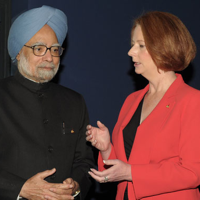In supporting her proposal to reverse the Australian ban on uranium exports to India at the Australian Labour Party’s conference in early December, Prime Minister Julia Gillard argued that, “We should take a decision that is in our nation's interest, a decision about strengthening our strategic partnership with India in this, the Asian century." The proposal, which was successfully passed at the conference, comes at a time when U.S. President Barack Obama is orchestrating Washington’s strategic pivot to Asia and signals that further space is being negotiated for India in the existing regional order. Washington seems to be using its military allies such as Australia and Japan to explore Indian participation in an evolving Indo-Pacific security and economic architecture, one that is probably more about creating stability in a geo-economic sphere where India and China will be the most dynamic players than about balancing China’s rise.
India-Australia diplomatic ties had been somewhat uneven in the past decade, marred at times by tensions over issues such as attacks on Indian expatriate students in Australian cities. Australia’s refusal to supply uranium to India on the grounds that New Delhi was not a signatory to the NPT, even as it supplied China with uranium despite the latter’s proliferation record vis-à-vis Pakistan, was also seen by India as a sign of inconsistency in Australia’s stated desire to strengthen ties. Until 2008, Indian planners were more tolerant of Australia’s concerns, given the latter’s long-standing policy not to engage in nuclear trade with countries outside the NPT. However, following New Delhi’s NSG waiver, which Australia actually supported, Canberra’s policy seemed incongruous with the emerging global scenario, so much so that Indian Prime Minister Manmohan Singh actually skipped the Commonwealth Heads of Government Meeting in Australia last year to express New Delhi’s displeasure on the issue.
Despite these differences, bilateral trade continued to grow rapidly, almost reaching the $20 billion mark in 2009-2010. However, this trade is heavily skewed in Australia’s favor, with exports from Down Under making up 90 percent of it by value. It is also essentially a resource relationship, with coal, nonmonetary gold, copper ores and concentrates, and petroleum accounting for 80 percent of Australian exports to India. Now, given the Indian push to industrialize faster and the fact that India is already Australia’s fourth-largest trading partner, it is easy to see why Australian Defense Minister Stephen Smith dubbed the relationship with India as one of Australia’s most important ones during his visit to Mumbai last December.

